The Museum Collections
Introduction
I. History and Art Collection
1. Icons of the 14th – 19th centuries
icons of the 14th – 17th century
2. Jewelry art of the 14th – 20th century
jewelry art of the 14th – 17th century
jewelry art of the 18th – 19th century
the european silver 14th - 19th centuries
3. Small-size sculptures (works of metal, wood, bone)
XI – the beginning of the XX century
Small-size sculptures 11th – 17th century
Small-size sculptures 18th – early 20th century
enamel of Troitza masters 15-8th – early 20th century
5.Embroidery, lace, textiles of the 14th - early 20th century
icon and ornamental embroidery
gold and silver lace
6.Painting of the 18th – 21st centuries
painting of the 18th – 19th centuris
painting of the 20th – 21st centuris
II.Manuscripts and old printed books of the 14th – 17th century
IV.Lithography of the 18th – 19th century
V.Numismatics
VI.Medals of the 18th - early 20th century
VIII.Archeology collection
IX. Russian folk and applied and decorative art of the 17th – 21st c.
1. Artistic wood
folk carved and painted wood
wooden toys
house carving of Sergiev Posad
Khokhloma and Gorodets painting
2. Artistic textiles
embroidery and weaving
printed textiles and lace
Russian shawls
folk costumes
folk garments
printed cotton kerchiefs
|
Jewelry Art of the 18th – 19th centuries (page 2)
|
|
In 1768 and in 1769 a famous court master K.I. Elers made a silver plate with the scene “The Miracle of Iona” and a silver jug with the head of an eagle on the lid. G.I. Serebryannikov used baroque shapes in the gilded cover of 1741 for the early 18th century Gospel. The whole surface of the obverse was covered with a thick floral pattern. The cover of the small Pontifical Service Book, donated by Metropolitan Platon in 1789, is decorated with a light refine filigree pattern of interweaving sprouts and flowers.
|
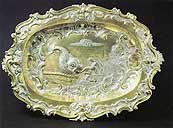
Plate. 1768. St. Petersburg. Work of K.I. Elers. Made by the order of Platon Levshin
|
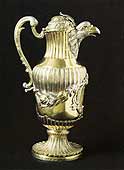
Jug. 1769. Work of K.I. Elers. Made by the order of Platon Levshin |
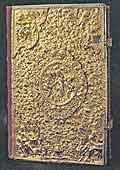
Gospel cover. 1741. Moscow. Work of G.I. Serebryanikov |
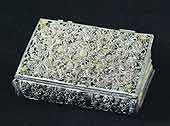
Cover of the Pontifical Service Book. Second half of the 18th century.
|
The Museum collection comprises various liturgical crosses of different size and shape. One of the best specimens of “prayer” or “blessing” crosses belonged to Metropolitan Platon Levshin. The christcross with an attachable handle is carved in wood in rococo style and framed in a silver filigree case. The liturgical cross with
eight ends, donated to the Trinity-St. Sergius Lavra by widowed landlady Ivanovskaya, was regilded and fixed on the silver crosier of Metropolitan Filaret in the 19th century.
The goblet, made by a Moscow craftsman, has numerous analogues in European art. It is made of coconut, framed in silver and decorated with gilding, chasing and carving. The remarkable holy water basin (used as a tureen) was made by P.T. Vorobei. The elaborate baroque or more balanced ornamental compositions, combination of gilded and white silver and fine chasing are characteristic of many 18th century works.
|
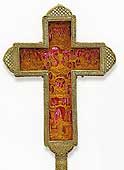
Prayer cross. Late 18th century. Moscow |

Church service cross. Early 18th century. Moscow |
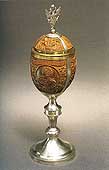
Goblet. 1796. Moscow. Donated by Metropolitan Filaret (Drozdov) |
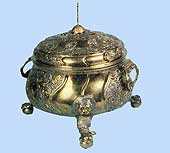
Holy water basin. 1765. Moscow. Work of P.T. Vorobei. Donated to the Trinity-St. Sergius Monastery by I.Ya. Khlebnikova
|
Among the royal presents of the 19th century there is the salt-cellar, donated “to the coffin of St. Sergius” by Grand Princess Elena Pavlovna in 1833. Enameled plaques in combination with strasses and precious stones were traditional decorations of silver church vessels. They were used in the chalice decorated with chasing in high relief and sculptural casting that was made by E.A. Antipiev.
In the Lavra archive documents a group of royal donations was recorded. It included a number of gold icon-lamps, precious chalices and a luxurious topaz cross “covered with two rows of diamond sparkles”. Most beautiful were coronation presents of Emperor Alexander II and Empress Maria Feodorovna.
The fancy candlestick, made in 1856 by I. Nordberg,
is distinguished by elaborate chasing.
|
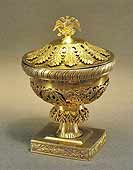
Salt-cellar. Moscow. Craftsman N.V. 1833. Donated in 1833 by Grand Princess Elena Pavlovna. |
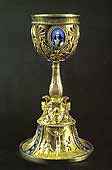
Chalice. 1832. Moscow. Craftsman E.A. Antipjev and monogram scribe “M.O.”. Donated in 1835 by Alexandra Matveyevna Alexeyeva, the wife of a Moscow priest. |
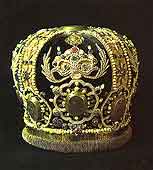
Mitre. Second half of the 16th – 1868. Moscow. The TrinitySt. Sergius Lavra.
|
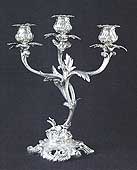
Candlestick. St. Petersburg. 1857. Work of I.Nordberg. Donated by V.P. Pismenskaya in 1859 |
|


